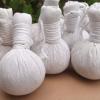CYBERMED LIFE - ORGANIC & NATURAL LIVING
CYBERMED LIFE - ORGANIC & NATURAL LIVING
 Warming Compresses: A warm compress can be used to relieve many physical ailments, including stomach cramps or muscle pain. You can buy a warm compress, or heat pack, at a local pharmacy or home supply store, but you can also make your own out of simple household materials. When using a warm compress, do not make it too hot, as it can burn the skin or possibly worsen your symptoms.
Warming Compresses: A warm compress can be used to relieve many physical ailments, including stomach cramps or muscle pain. You can buy a warm compress, or heat pack, at a local pharmacy or home supply store, but you can also make your own out of simple household materials. When using a warm compress, do not make it too hot, as it can burn the skin or possibly worsen your symptoms.